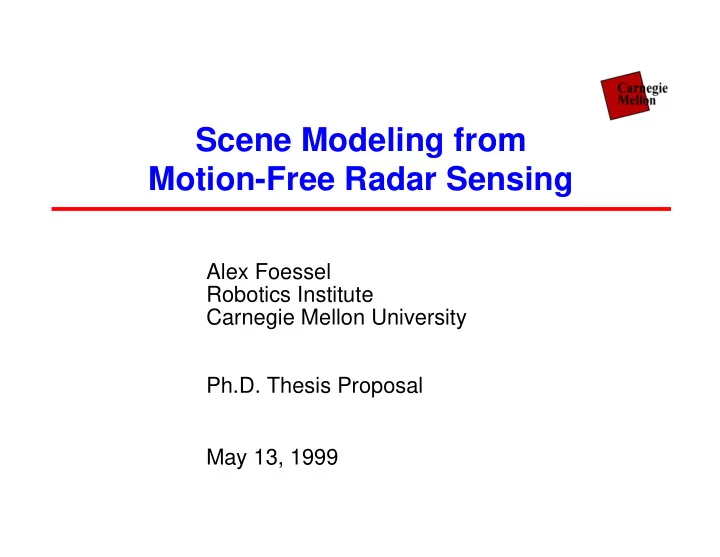

Scene Modeling from Motion-Free Radar Sensing Alex Foessel Robotics Institute Carnegie Mellon University Ph.D. Thesis Proposal May 13, 1999
Motivation - 2 -
Presentation I. Research on Radar for Robots II. Work to Date III. Radar Issues IV. Technical Approach V. Research Plan VI. Summary - 3 -
Related Work 1. M. Lange and J. Detlefsen, “94 GHz Three-Dimensional Imaging Radar Sensor for Autonomous Vehicles,” 1991. 2. D. Langer, “Proposal for an Integrated MMW Radar System for Outdoor Navigation,” 1996. 3. U.S Patent No. 5,668,739 "System and Method for Tracking Objects Using a Detection System", 1997. 4. S. Clark and H. Durran-Whyte, “Autonomous Land Vehicle Navigation Using Millimeter Wave Radar,” 1998. 5. S. Boehmke, J. Bares, E. Mutschler, K. Lay, "A High Speed 3-D Radar Scanner for Automation," 1998. - 4 -
Work to Date • Mechanically-scanning radar unit characterization (experimental estimation of range accuracy, range resolution and beamwidth) • Motion-free scanning-antennas study (reveals specific issues for radar interpretation) • 2-D evidence-grid implementation (radar data merging tool, shows noise reduction) - 5 -
RA dio D etection A nd R anging Am plitude Range • Millimeter-wave band (4 mm) • Range of interest from 1 to 100 m - 6 -
Wide-Beam Scene Sensing • Large footprint --> combination of echoes • Three-dimensional modeling - 7 -
Experimental Range Resolution Targets 2.0 m apart 1.5 m apart 1.0 m apart 0.5 m apart 2 4 6 8 10 12 2 4 6 8 10 12 2 4 6 8 10 12 2 4 6 8 10 12 Range (m) Range (m) Range (m) Range (m) • Range resolution limited to two range intervals - 8 -
Antenna-Radiation Pattern Schematic Graph Representation Representation Amplitude 0 -90 90 Angle (deg) • Beamwidth less than 10 degrees - 9 -
Experimental Beamwidth Signal Strength at 6.5 meters from Radar 600 ...... 500 Signal Strength 400 Signal Strength (no units) 300 200 100 0 −5 −4 −3 −2 −1 0 1 2 3 4 5 -5 -4 -3 -2 -1 0 1 2 3 4 5 Angle (degrees) Angle (degrees) • Experimental estimation of beamwidth - 10 -
Multilobe Angular Ambiguity e d u t i l p m A Range - 11 -
Motion-Free Scanning Antenna Am plitude Amplitude -30 -30 X-Scan (deg) 3 30 -15 -15 X-Scan (deg) 15 15 0 0 0 0 Y-Scan (deg) ) 15 g 15 e d -15 ( -15 n a c S - Y X-Scan Angle (deg) • Electronic scanning of the beam • Provides size reduction and reliability improvement - 12 -
Motion-Free Scanning Antenna Varying Radiation Pattern Amplitude -20 -10 0 10 20 Scanning angle (deg) Scanning angle = -17 deg Scanning angle = +11 deg - 13 -
Specular Reflection (a) Am plitude (a) Range • Fails detection of specular surface • Potential false target detection - 14 -
Radar-Issues Summary • Large footprint --> combination of targets • Multilobe sensing --> angular ambiguity • Motion-free scanning antenna --> varying properties • Specular surfaces --> missing surface and false target • Orientation and material determine radar energy return - 15 -
Technical Approach • Learn radar-signal heuristics • Represent multilobe-sensor profile • Enable varying profile capability • Model surface reflectance and orientation • Integrate in evidence grids appropriate for radar - 16 -
Identification of Planes A Radar Sensing a Plane B C Resulting Return-Energy Vector Range Spread • Initial indication of a diffuse reflection plane - 17 -
Experimental Range Accuracy Target at 10.5 m Target at 10.6 m Amplitude Amplitude 8 9 10 11 12 8 9 10 11 12 Range (meters) Range (meters) • Indicates accuracy can improve over range interval - 18 -
Improvement of Range Accuracy Experimental Data Amplitude 8 9 10 11 12 Range (meters) • Target at 10.6 m • Max. value technique estimates 10.50 m • Proposed technique estimates 10.58 m - 19 -
Evidence Grids, A Convenient Representation • Probabilistic scene representation for noisy sensors • Works for wide-beam sensors • Allows extension to multilobe profiles • Facilitates representation of additional hypotheses (specifically, orientation and reflectance) • Representation commonly used for robotic tasks - 20 -
Evidence-Grid Implementation Convex Obstacle Sensor Locations Concave Obstacle Evidence Grid • Data merging results in noise attenuation - 21 -
Angular Ambiguity Resolution (A) (B) • Successive observations resolve angular ambiguity. - 22 -
Multilobe-Sensor Profile Schematic Sensor-Profile Representation Geometry Evidence Grid • Sensor profile represents sensor geometry - 23 -
Varying Radiation-Pattern Evidence Grid Amplitude − 8 − 4 0 4 8 Azimuth (degrees) Evidence Grid Amplitude − 24 − 28 − 32 − 36 − 40 Azimuth (degrees) - 24 -
Surface Orientation and Reflectance Amplitude Range High Evidence Evidence of diffuse reflection Negative evidence • Sensor profile updates additional hypotheses - 25 -
Surface Model Enhancement Grid values U U U (orientation) (roughness) E Surface Model E E E E • Global approach for surface modeling - 26 -
Surface Model for Improved Interpretation Sensor-Profile Schematic Geometry Representation Evidence Grid • Known surface properties indicate stronger evidence - 27 -
Interpretation Process 1. Obtain radar data 2. Apply radar-data heuristics 3. Build sensor profile 4. Update evidence grid 5. Model surface reflectivity and roughness 6. Iterate... - 28 -
Research Plan 1. Radar-interpreter design ( Jun–Jul 1999) 2. Radar-data heuristics development ( Aug–Sept 1999) 3. Radar-sensor profile development (Oct–Nov 1999) 4. Surface-extraction development (Dec 1999–Jan 2000) 5. Integration of interpreter components (Feb–Mar 2000) 6. Interpreter evaluation (Apr– May 2000) 7. Dissertation composition, presentation (J un–Aug 2000) - 29 -
Summary I. Previous Radar Developments for Robotics II. Work to Date (radar unit characterization, motion-free scanning antenna research, 2-D evidence grid) III. Radar Shortcomings (footprint, sidelobes, reflections, varying radiation pattern) IV. Technical Approach (heuristics, evidence grids, multilobe-sensor profile, surface modeling) V. Research plan - 30 -
Questions and Answers ? - 31 -
- 32 -
Recommend
More recommend